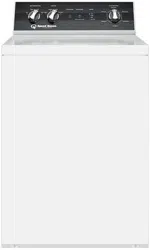Loading ...
Loading ...
Loading ...

Wash Temperature
Hot
Hot water is the most effective for cleaning, but it is not recom-
mended for all fabric types (read labels).
Warm
The Warm Wash is useful for providing a thorough cleaning on
light and moderately soiled clothing without damaging fabric
or adding to color fading. Warm water also reduces wrinkling.
Warm water can also be used in the rinse water. Use with non-
colorfast or dark colors, permanent press, silks, woolens, ny-
lon, and acrylic.
Cold
The Cold Wash is ideal for delicate items. Although its cleaning
abilities are not as great as with hot or warm water, it is useful
for colors that bleed easily and for sensitive fabrics.
The Warm/Warm temperature selection will use warm rinse
water. All other rinses use cold water. It is the most beneficial
for fabrics. Cold rinses reduce wrinkling and color fading. In
addition, cold rinses will save money and energy.
NOTE: In wash temperatures colder than 60°F [16°C],
detergents do not dissolve well. This may cause inef-
fective cleaning, or lint and residue to form.
NOTE: Always follow manufacturer’s care labels.
Water Supply Temperature
Water temperature is determined by the temperature of the in-
coming water supply. The washer does not heat or cool the wa-
ter.
For example, northern climates will have much colder incom-
ing water during the winter months. Southern climates will
have much warmer cold water during the summer months.
Wash Temperature Guide
Water
Temperature Use Comments
HOT • Sturdy whites
and colorfast
items
• Work clothes
• Soiled items
• Diapers
• Best cleaning
for items soiled
with oily or
greasy stains,
grass, or ink.
WARM • Light and mod-
erately soiled
items
• Non-colorfast
or dark colors
• Permanent
press
• Silks, woolens,
nylon, acrylic
• Rinsing of
some items
• Reduces wrin-
kling in perma-
nent press fab-
rics
• Less fading
• Reduces
shrinking in
knits
COLD • Non-colorfast
fabrics
• Extra delicate
clothing
• Saves energy
• Reduces color
fading
• Reduces wrin-
kling
• Reduces
shrinking
Table 1
Energy
You can save energy when washing by following a few guide-
lines:
1. Heating water accounts for the greatest energy expense
when washing. Save on heating water by using warm or
cold washes.
2. Wash full loads, but do not overload.
3. Use Soak option for heavily soiled items to reduce the need
for higher soil level selections.
Operation
©
Copyright, Alliance Laundry Systems LLC -
DO NOT COPY or TRANSMIT
10 Part No. 203967ENR2
Loading ...
Loading ...
Loading ...
